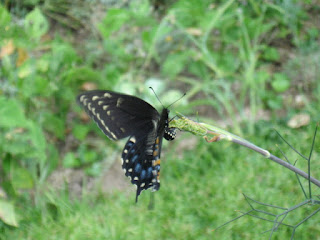First up is this squirrely individual. With all of the rain we've had this summer you'd think that I had a mushroom farm here at the Celtic Gardens! We have these ginormous white mushrooms out front that garden fairies would fight over. Well I snapped this shot of this little guy munching away at one. Heck, I didn't even know squirrels ate such vegetation.
Dragonflies are a common sight in the garden. According to Smithsonian, there's over 5,000 species all belonging to the Odonata order which means "toothed one" in Greek, referring to the serrated teeth of dragonflies. Now the following information reads much like a cheap low-budget film in the making, so here we go. There's two stages in the life of a dragonfly. In their larval stage which can last over two years dragonflies are aquatic beings. They eat tadpoles, mosquitoes, fish other insect larvae and even other dragonfly larvae. At the end of its larval stage the dragonfly crawls out of the water. Its exoskeleton cracks open and releases the insect's abdomen that's been packed into the shell much like a telescope. Its four wings are released and dry off. (Cue the epic music and fog machine please and roll the cameras!) The head of a dragonfly is pretty much its eye so their vision is nearly panoramic. Adult dragonflies are beneficial in the garden for mosquito control which is their mainstay.
The first individual - Goldie - was hastily shot from the deck as it calmly perched on the Japanese Persimmon. See it on the left?
The second individual kept me company whilst picking blueberries out in the countryside of Stedman. This one had it's own zip code, I do believe. What really interests me about animals as well as insects is their ability to engage you with their eyes. I mean they look you eye to eye. Really amazing, me thinks.
So in the next series we're featuring the life cycle of the Eastern Black Swallowtail. Butterflies invoke a certain joy and happiness reminiscent of my girlhood days of old. Although I have yet to see a Monarch butterfly this year Eastern Black Swallowtails repeatedly make their presence and home at Celtic Gardens.
The story begins with a single female. She hovered at the fennel and laid her eggs in the newly formed bloom.
In a few days the eggs hatched. The larvae had an instant food source and they found nourishment from the tender growth of newly formed sprigs.
When the eggs hatch the larvae are very small. These pictures were from larvae from earlier this summer. The female also chooses dill and carrot leaves as suitable homes for her eggs.
This is what the actual caterpillar looks like in a few weeks. As the plant is consumed its growth is rapidly gained.
I have yet to find a cocoon but as I'm hunting for them when i find one I'll post the picture. Some gardners like me purposely plant herbs like fennel, parsley and dill to support butterfly habitat. Again carrot greens are another favorite so consider including a few extra plants dedicated to supporting their needs. You'll be rewarded with their presence and company in your garden.
That concludes this weeks creepy crawly installation. Bug spray not included but will be sold at this weeks City Farmers Market. (shameless plug? You betcha!)
And as always may happiness be a ray of sunshine in your mind, body and soul!
 |
| Baby Mantis blog bomb! |








No comments:
Post a Comment